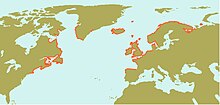Ascophyllum
| Ascophyllum | |
|---|---|
 |
|
| Scientific classification | |
| (unranked): | SAR |
| Superphylum: | Heterokonta |
| Class: | Phaeophyceae |
| Order: | Fucales |
| Family: | Fucaceae |
| Genus: |
Ascophyllum Stackhouse, 1809 |
| Species: | A. nodosum |
| Binomial name | |
|
Ascophyllum nodosum (L.) Le Jolis |
|
 |
|
| Distribution | |
Ascophyllum nodosum is a large, common brown alga (Phaeophyceae) in the family Fucaceae, being the only species in the genus Ascophyllum. It is seaweed of the northern Atlantic Ocean, also known as rockweed, Norwegian kelp, knotted kelp, knotted wrack or egg wrack. It is common on the north-western coast of Europe (from Svalbard to Portugal) including east Greenland and the north-eastern coast of North America.
A. nodosum has long irregularly dichotomously branched fronds with large, egg-shaped air bladders set in series at regular intervals in the fronds and not stalked. The fronds can reach 2 m in length and are attached by a holdfast to rocks and boulders. The fronds are olive-green, olive-brown in color and somewhat compressed, but without a midrib.
Its life history is of one diploid plant and gametes. The gametes are produced in conceptacles embedded in yellowish receptacles on short branches.
Several different varieties and forms of this species have been described.
Free-floating ecads of this species are found in, for example, A. n. mackaii Cotton, which is found at very sheltered locations, such as at the heads of sea lochs in Scotland and Ireland.
A. nodosum is found mostly on sheltered sites on shores in the midlittoral, where it can become the dominant species in the littoral zone.
...
Wikipedia
